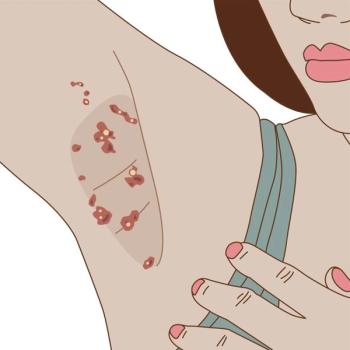
Second-Degree Burn From Iontophoresis
Half way through a 15-minute iontophoresis treatment for de Quervain tenosynovitis of the right wrist, a 42-year-old woman felt exquisite pain but completed the session. After the therapist returned to the room and removed the electrodes, a light gray circular mark about 5 mm in diameter was noted on the skin. The epidermis was gone, and the underlying dermis was also injured. Within 6 hours, a tender, dark red-brown lesion developed.
Click to Enlarge
Half way through a 15-minute iontophoresis treatment for de Quervain tenosynovitis of the right wrist, a 42-year-old woman felt exquisite pain but completed the session. After the therapist returned to the room and removed the electrodes, a light gray circular mark about 5 mm in diameter was noted on the skin. The epidermis was gone, and the underlying dermis was also injured. Within 6 hours, a tender, dark red-brown lesion developed.
The patient had not undergone iontophoresis before, and this was the first treatment for her wrist pain, which was localized to the anatomic snuffbox. She also had type 2 diabetes mellitus.
It was suspected that poor contact between the electrode and the skin had caused an arcing effect that resulted in the second-degree burn. The wound healed slowly over 6 weeks with daily saline irrigation and application of triple antibiotic ointment and a bandage. During week 5, mild debridement of a thick, yellow-green eschar was needed. The wound did not become infected.
Iontophoresis can be used to deliver a dose of corticosteroid (in this case, dexamethasone) to an inflamed tendon without the risks associated with direct injection or systemic oral therapy.1 However, it is important to ensure proper electrode contact and placement; also, the patient should be monitored during the session.
References:
REFERENCE:1. Moser K, Kriwet K, Naik A, et al. Passive skin penetration enhancement and its quantification in vitro. Eur J Pharm Biopharm. 2001;52:103-112.
Newsletter
Enhance your clinical practice with the Patient Care newsletter, offering the latest evidence-based guidelines, diagnostic insights, and treatment strategies for primary care physicians.















































































































































































































































































